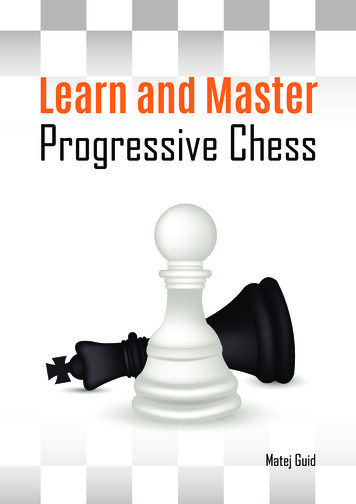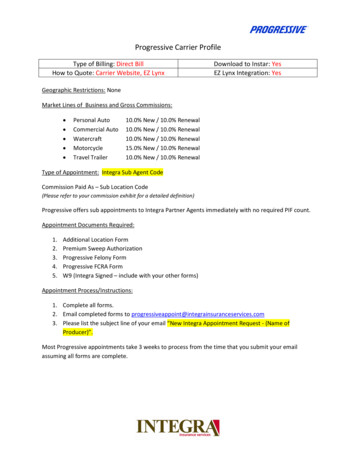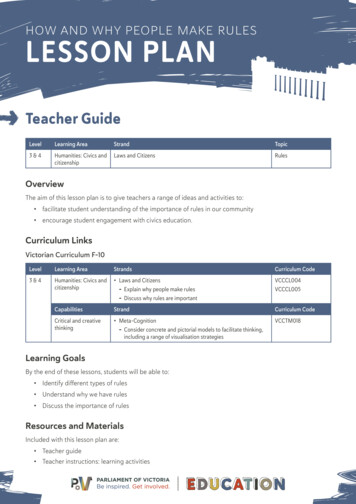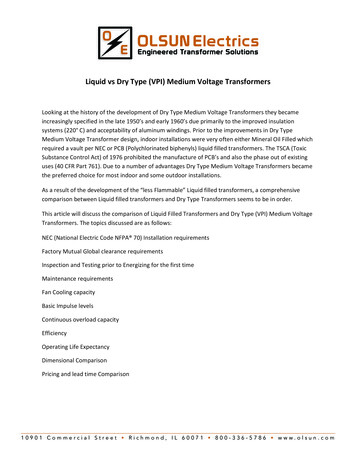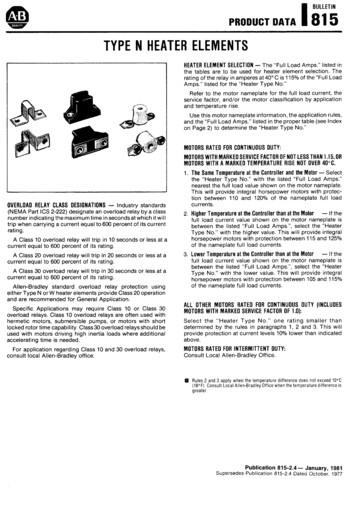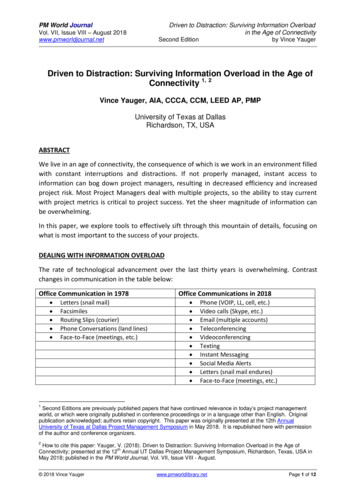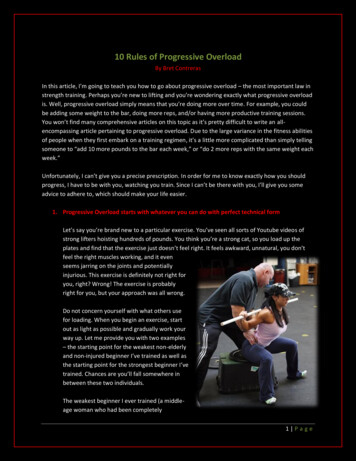
Transcription
10 Rules of Progressive OverloadBy Bret ContrerasIn this article, I’m going to teach you how to go about progressive overload – the most important law instrength training. Perhaps you’re new to lifting and you’re wondering exactly what progressive overloadis. Well, progressive overload simply means that you’re doing more over time. For example, you couldbe adding some weight to the bar, doing more reps, and/or having more productive training sessions.You won’t find many comprehensive articles on this topic as it’s pretty difficult to write an allencompassing article pertaining to progressive overload. Due to the large variance in the fitness abilitiesof people when they first embark on a training regimen, it’s a little more complicated than simply tellingsomeone to “add 10 more pounds to the bar each week,” or “do 2 more reps with the same weight eachweek.”Unfortunately, I can’t give you a precise prescription. In order for me to know exactly how you shouldprogress, I have to be with you, watching you train. Since I can’t be there with you, I’ll give you someadvice to adhere to, which should make your life easier.1. Progressive Overload starts with whatever you can do with perfect technical formLet’s say you’re brand new to a particular exercise. You’ve seen all sorts of Youtube videos ofstrong lifters hoisting hundreds of pounds. You think you’re a strong cat, so you load up theplates and find that the exercise just doesn’t feel right. It feels awkward, unnatural, you don’tfeel the right muscles working, and it evenseems jarring on the joints and potentiallyinjurious. This exercise is definitely not right foryou, right? Wrong! The exercise is probablyright for you, but your approach was all wrong.Do not concern yourself with what others usefor loading. When you begin an exercise, startout as light as possible and gradually work yourway up. Let me provide you with two examples– the starting point for the weakest non-elderlyand non-injured beginner I’ve trained as well asthe starting point for the strongest beginner I’vetrained. Chances are you’ll fall somewhere inbetween these two individuals.The weakest beginner I ever trained (a middleage woman who had been completely1 P a ge
sedentary for around 15-years) had to start out with bodyweight high box squats on theadjustable step-up platform so that she was only descending around 8 inches before sitting onthe box. This same client also performed glute bridges, step-ups from a 4” step, and hip-hingedrills – all done with just bodyweight.But guess what? She was squatting, hip thrusting, step-upping, and deadlifting. Granted, shewas performing the most remedial variations of those exercises, but this is what was right forher at the time. Within six months she was doing goblet full squats, barbell hip thrusts, Bulgariansplit squats, and deadlifts from the floor with 95 lbs.Conversely, the strongest beginner (a high-school wrestler) I ever trained was able to use 185 lbsfor full squats, 225 lbs for deadlifts, 225 lbs for hip thrusts, 155 lbs for bench press, and could doBulgarian split squats, single leg hip thrusts, and chin ups with great form. Though he was anathlete, surprisingly he had never lifted weights before. Sports had strengthened his legs andupper body so that he was able to start out at a much more advanced level than mostbeginners. Even my (at the time) 13-year old niece, a very good volleyball player, full squatted95 lbs, trap bar deadlifted 135 lbs, and single leg hip thrusted (all with excellent form) in hervery first weight training session.But these people are not you. You’ll find that due to your unique body type, you’ll have anadvantage with some exercises and a huge disadvantage with others. Long femurs? Youprobably won’t set any squat records, but your weighted back extension strength is going to kicksome serious butt. Long arms? Kiss your bench press records goodbye, but you’re gonna be adeadlifting rockstar.Figure out where you belong on the regression-progression continuum (this is basically a list ofeach variation of an exercise from the easiest possible version to the most challenging version)and start getting stronger.2. Progressive Overload for beginners involves a few tenetsProgressive overload methodology is different forbeginners compared to more advanced lifters. It’s alsodifferent for men compared to women and for thosecarrying a lot of muscle versus those not carrying muchmuscle. For example, I can’t just tell a woman who isbrand new to strength training to just add ten poundsto the bar for squats and deadlifts each week. First ofall, chances are some work has to be done just to gether to squat and deadlift properly, before ever focusingon load. Some clients should start out with partial range2 P a ge
lifts such as bodyweight box squats and rack pullsand simply work on “progressive distance training,”whereby the range of motion is slightly increasedeach week. If you keep squatting your ownbodyweight (or rack pulling 65lbs) for 3 sets of 10,but each week you descend an inch deeper, that’sprogressive overload. Eventually you’ll be using afull range of motion and can then concern yourselfwith adding load.With exercises that have you moving a significantportion of your body, such as squats, hip thrusts,back extensions, and lunges, you must master yourown bodyweight before adding load. I like myclients to be able to perform 3 sets of 20 full-ROMreps with bodyweight exercises before adding load.Furthermore, many lifts require very small jumps in load over time, and attempts in theseparticular exercises should usually involve jumps in repetitions instead of load. This applies tolifts that utilize smaller loads, for example curls and lateral raises, in addition to challengingbodyweight movements such as skater squats, single leg RDLs, single leg hip thrusts, andprisoner single leg back extensions.This is especially important for women or smaller men when access to smaller plates (1.25lb or2.5lb plates) or smaller jumps in dumbbell (ex: 17.5lbs) or kettlebell loads aren’t possible. Thinkabout it – going from 50 to 55 lb dumbbells is a 10% jump in weight. However, going from 10 to15 lb dumbbells is a 50% jump in weight. You cannot expect someone to make a 50% jump inload and execute the same number of repetitions as the week before, but you can expect themto get another rep or two with the same load. So let’s say that one week you perform dumbbellrear delt raises with 10lbs for 10 reps. The next week, rather than up the load to 15lbs, tryperforming 12 reps with the 10lb weights. When you get to a point where you can do a coupleof sets of 20 reps, then jump the weight up to 15 lbs.3. Progressive Overload can be achieved in a variety of ways (12 primary ways I can think of)Remember, progressive overload is simply “doing more over time.” There are many ways to goabout this. In this article, I’ve already mentioned progressing in range of motion, repetitions,and load. In the beginning, you want to progress in range of motion and form. Yes, if you do thesame workout you did the week before, but with better form, that’s progression. You “didmore” for the neuromuscular system in terms of motor patterning and even muscle force sinceusing better form involves relying more on the targeted muscles.3 P a ge
After proper form and full range of motion are established and ingrained, now it’s time to worryabout progressing in repetitions and load. But these aren’t the only ways to progress. Here areall the practical ways I can think of: Lifting the same load for increased distance (range of motion)Lifting the same load and volume with better form, more control, and less effort(efficiency)Lifting the same load for more reps (volume)Lifting heavier loads (intensity of load)Lifting the same load and volume with less rest time in between sets (density)Lifting a load with more speed and acceleration (intensity of effort)Doing more work in the same amount of time (density)Doing the same work in less amount of time (density)Doing more sets with the same load and reps (volume)Lifting the same load and volume more often throughout the week (frequency)Doing the same work while losing body mass (increased relative volume)Lifting the same load and volume and then extending the set past technical failure withforced reps, negatives, drop sets, static holds, rest pause, partial reps, or postexhaustion (intensity of effort)Just remember, improvements in form and ROM come first, and increases in reps and load comesecond.4. Progressive Overload will never be linearMany strength coaches love to tell the story about Milo of Croton to illuminate the merits ofprogressive overload. Legend has it that Milo used to pick up a baby calf every day and carry itaround on his shoulders. As the calfgrew, Milo got stronger. EventuallyMilo was hoisting a full-size bull andbusting out sets of yoke walks like itain’t no thang. Pretty sweet story,right?Unfortunately this story is a crock ofbull (pun intended). First of all, a halfton bull would be way too awkwardto carry due to the lopsided natureand sheer size of the animal. But thisis irrelevant.4 P a ge
No gains from weight training, be it mobility, hypertrophy, strength, power, endurance, or fatloss, will ever occur in a linear nature. The body doesn’t work that way. Adaptations happen inwaves. Sometimes you’ll make big jumps in a single week in a particular quality, while othertimes you’ll stall for three months in another quality. Over the long haul, everything goes up, butit’s a windy road. There are physiological reasons for this phenomenon, which is beyond thescope of this article.However, let’s pretend for a minute that you could make linear progress for an entire year on aparticular lift. A 10lb jump per week equates to 520lbs in a year. Even a 5lb jump per weekequates to 260lbs in a year. Moreover, a 1 rep jump per week equates to 52 reps in a year, whilea 1 rep jump per month equates to 12 reps in a year. You won’t gain 260-520lbs in a year on anysingle lift. And you won’t gain 12-52 reps on most lifts either. It just ain’t happening. Somesessions you’ll be surprisingly strong and make big gains, some sessions you’ll simply tie yourprevious efforts, and some sessions you’ll actually be weaker and go backwards. But every sixmonths you’ll likely be stronger and fitter.These charts depict a woman’s progress over a one-year period in bodyfat percentage and leanbody mass in kilograms. She made the most dramatic transformation I’ve ever seen to date, butnotice the non-linear adaptations. Also notice the drop in muscle, despite doing everythingright. This woman gained a ton of strength on squats, deadlifts, hip thrusts, bench press, militarypress, rows, and chins, she never missed a training session, and she ate perfectly for an entireyear, yet she lost around 11 lbs of muscle during her year-long pursuit of getting into contestshape of below 10% bodyfat. Nevertheless, she won her first figure competition and is now apopular figure competitor.5. Progressive Overload will never be as fun as it is during your first 3 months of liftingIf you’re a beginner, sit back and enjoy the ride! Your rate of strength gain during your firstthree months of proper weight training will be higher than at any other time in your life. Eachweek you will slaughter personal records. Getting fifteen reps with something that you got foronly ten reps the previous week is not an uncommon occurrence. This is mostly due to rapid5 P a ge
gains in intermuscular coordination. Just don’t get spoiled, your rate of gain will slowdramatically and pretty soon you’ll be just like the rest of us – fighting like hell for those PR’s.6. Progressive Overload for veteran lifters requires serious strategy and specializationAs a beginner, you can pretty much do anything and gain strength as long as you’re consistent.After a couple of years of solid training, however, you have to be clever about yourprogramming in order to continue to reach new levels of strength. You’ll need to rotate yourlifts, plan your program designs intelligently, fluctuate your training stress, and tinker aroundwith methodologies. Eventually it becomes very difficult to pack more pounds onto a particularlift or even gain another rep.7. Progressive Overload is much harder when you’re losing weightUnless you’re a beginner, it’s highly challenging to increase your strength while simultaneouslydropping significant weight. In fact,simply maintaining your strengthwhile losing weight is a form ofprogressive overload as you’d beincreasing your relative strength(strength divided by bodyweight)and therefore “doing more overtime.”Some lifts are more affected byweight loss than others. Squats andbench press tend to take a big dive,whereas deadlits can sometimes stay put. Your strength endurance on bodyweight exercises forthe upper body will see a huge jump when you lose weight, however, so enjoy the boosts in repson push-ups, chins, dips, and inverted rows.8. Progressive Overload sometimes has a mind of its ownQuite often you’ll do everything right, but you won’t get stronger. The plan just won’t work.You’ll be lifting hard, adhering to an intelligent plan, eating well, and sleeping right, and yet youstill you won’t set any PR’s. Other times, you’ll do everything wrong, and you’ll somehow gainstrength. Your training can be derailed, your diet and sleep can go down the gutter, but you’ll goto the gym and set a PR. This makes absolutely no sense and flies in the face of sports science.Nevertheless, this is just how the body works sometimes. Physiology is tricky and multifactorial.Don’t get cocky when this happens and think that you’ve stumbled upon the secret system(excessive partying, eating junk food, and training sporadically). Whenever you engage in thesebehaviors for too long, it will backfire on you, so stay on track to the best of your abilities.6 P a ge
9. Progressive Overload should never be prioritized over proper formAt any point in time, if you really want to set a PR, you can just be lax on your form and likely seta record. For example, you could round your back excessively during deadlifts, bounce the baroff your chest with bench press, or use a little more body English with curls. However, this is aslippery slope that’s best avoided. Progressive overload only works when you challenge themuscles to do more over time, and your muscles will not be forced to do more if your form getssloppy. Moreover, you won’t be setting any personal records if you’re injured or constantly inpain.10. Progressive Overload requires standardized techniqueThe only way you will ever know whether you gained strength or not is to perform the liftsexactly the same way each time. In otherwords, true strength gains require properdepth, tempo, and execution. Many lifters lieto themselves and pretend that they’ve gottenstronger, but their ranges of motions diminishor their form goes out the window. Theselifters didn’t get stronger, they got sloppier.Federations in the sports of powerlifting,Olympic weightlifting, and strongman havecreated rules for their various exercises. It maybe worth your while to learn these rules so that you always perform them properly in trainingand when testing your max. Assuming you can perform the lifts properly, always squat toparallel or deeper, always lock out your hip thrusts and barbell glute bridges, and in generalalways control the weight through a full range of motion.Hopefully these 10 rules will keep you on track. I have one more piece of advice to share with you. Eventhe most seasoned lifters often have to take a step back in order to take two steps forward. Sometimeswe get caught up in chasing continuous PR’s to the point of altering form, relying on the wrong muscles,skimping on ROM, or training through pain. Once per year, I recommend “resetting” your strength levelsin your pursuit of progressive overload. Throw everything you’ve done in the past out the window andstart over using the best possible form through a full range of motion. This is your new baseline. Nowwork on adhering to that same form while doing more over time. Your body will thank you in the longrun for engaging in this simple yet effective practice.7 P a ge
10 Rules of Progressive Overload By Bret Contreras In this article, I'm going to teach you how to go about progressive overload - the most important law in strength training. Perhaps you're new to lifting and you're wondering exactly what progressive overload is. Well, progressive overload simply means that you're doing more over time.

